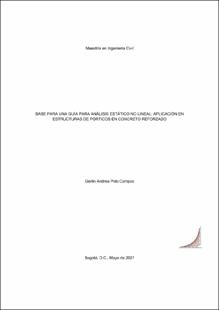Mostrar el registro sencillo del ítem
Base para una guía para análisis estático no lineal: aplicación en estructuras de pórticos en concreto reforzado
| dc.contributor.advisor | Jerez Barbosa, Sandra | |
| dc.contributor.author | Polo Campos, Gerlin Andrea | |
| dc.date.accessioned | 2021-08-04T19:51:53Z | |
| dc.date.accessioned | 2021-10-01T15:35:46Z | |
| dc.date.available | 2021-08-04T19:51:53Z | |
| dc.date.available | 2021-10-01T15:35:46Z | |
| dc.date.issued | 2021 | |
| dc.identifier.uri | https://repositorio.escuelaing.edu.co/handle/001/1651 | |
| dc.description.abstract | La NSR-10 reconoce como método de análisis del sistema de resistencia sísmica el procedimiento no lineal estático de plastificación progresiva “PUSH-OVER”, aclarando que su uso se permite cuando el ingeniero diseñador desee evaluar la capacidad de disipación de energía en el rango inelástico, en Colombia se hace uso del análisis en los estudios de evaluación y rehabilitación sísmica de edificaciones. Estos métodos tienen una complejidad asociada a la filosofía que hay detrás de ellos, la ingeniería basada en desempeño, con respecto a los métodos de diseño convencional. El presente proyecto tiene como objetivo ofrecer una guía paso a paso para la implementación de los métodos de análisis estático no lineal en pórticos de concreto reforzado, como una herramienta práctica para los ingenieros estructurales, que contribuya a la compresión y aplicación de estas metodologías. | spa |
| dc.description.abstract | In Colombia, non-linear static analysis is currently used in some cases in the evaluation and seismic rehabilitation of buildings. seismic evaluation and rehabilitation studies of buildings, at the discretion of the professional in charge. in charge. The NSR-10 recognizes as a method of analysis of the seismic resistance system the nonlinear procedure for the analysis of the seismic resistance system. the nonlinear static progressive plasticization "PUSH-OVER" procedure, that its use is permitted when the design engineer wishes to evaluate the energy dissipation capacity of the of energy dissipation in the inelastic range. Likewise, appendix A-3 of the Appendix A-3 of the Regulation provides a brief explanation of the procedure, making it necessary to rely on ATC 40 (ATC 40). ATC 40 (SSC, 1996), "Seismic Evaluation and Retrofit of Concrete Buildings", as updated by the F.S.C., 1996. Buildings", updated by FEMA 440 "Improvement of Nonlinear Static Static Seismic Analysis Procedures" and in FEMA 356 "Prestandard and Commentary for the Seismic Rehabilitation of Buildings", also updated by FEMA 356. of Buildings", also updated by ASCE 41-17 "Seismic Evaluation and Retrofit of Existing Buildings". Existing Buildings." These new updates to the standards present improvements to the procedures for implementing the These new updates of the standards present improvements in the procedures for the implementation of the capacity spectrum method and the method of coefficients, allowing for better method, allowing better results to be obtained. These methods have a complexity associated with the philosophy behind them, the performance-based engineering, with respect to conventional design methods. For For this reason, it is important to have guidance documents for their application. Currently, there are no documents explaining such application in detail are not currently known. This paper aims to provide a basis for The present work aims to provide a basis for developing a guide for the application of two common methods of nonlinear static analysis in reinforced concrete frames two common methods of nonlinear static analysis of reinforced concrete frames: the capacity spectrum method and the capacity spectrum method. method and the displacement coefficient method; the latter, indicated in the NSR-10 Regulation to carry out this type of analysis. The purpose of this document is to to contribute to the understanding and proper application of the above mentioned methods with a practical tool for with a practical tool for structural engineers. | eng |
| dc.format.extent | 283 páginas | spa |
| dc.format.mimetype | application/pdf | spa |
| dc.language.iso | spa | spa |
| dc.title | Base para una guía para análisis estático no lineal: aplicación en estructuras de pórticos en concreto reforzado | spa |
| dc.type | Trabajo de grado - Maestría | spa |
| dc.type.version | info:eu-repo/semantics/publishedVersion | spa |
| oaire.accessrights | http://purl.org/coar/access_right/c_abf2 | spa |
| oaire.version | http://purl.org/coar/version/c_970fb48d4fbd8a85 | spa |
| dc.description.degreelevel | Maestría | spa |
| dc.description.degreename | Magíster en Ingeniería Civil | spa |
| dc.identifier.url | https://catalogo.escuelaing.edu.co/cgi-bin/koha/opac-detail.pl?biblionumber=22716 | |
| dc.publisher.program | Maestría en Ingeniería Civil | spa |
| dc.relation.indexed | N/A | spa |
| dc.rights.accessrights | info:eu-repo/semantics/openAccess | spa |
| dc.subject.armarc | Estructuras | |
| dc.subject.armarc | Concreto reforzado | |
| dc.subject.proposal | Estructura de pórticos | spa |
| dc.subject.proposal | Gantry structure | eng |
| dc.subject.proposal | Concreto reforzado | spa |
| dc.subject.proposal | Reinforced concrete | eng |
| dc.type.coar | http://purl.org/coar/resource_type/c_bdcc | spa |
| dc.type.content | Text | spa |
| dc.type.driver | info:eu-repo/semantics/masterThesis | spa |
| dc.type.redcol | https://purl.org/redcol/resource_type/TM | spa |
Ficheros en el ítem
Este ítem aparece en la(s) siguiente(s) colección(ones)
-
CF - Trabajos de Grado Maestría en Ingeniería Civil [426]
Trabajos de Grado de la Maestría en Ingeniería Civil de la Escuela Colombiana de Ingeniería Julio Garavito











